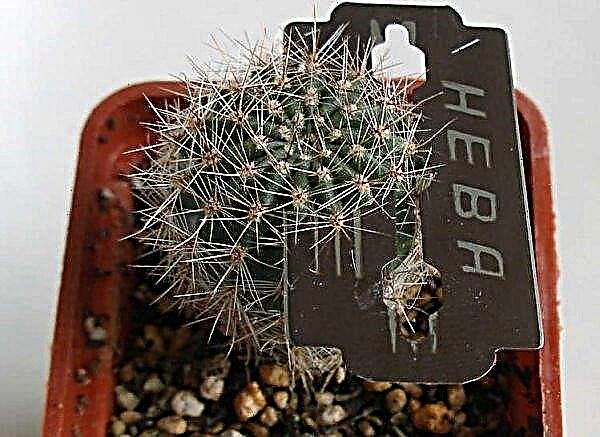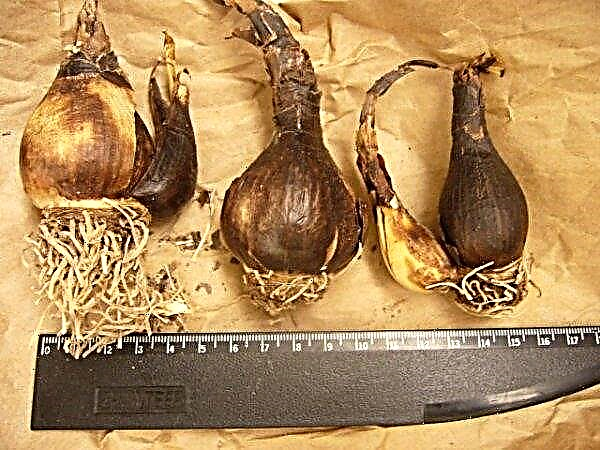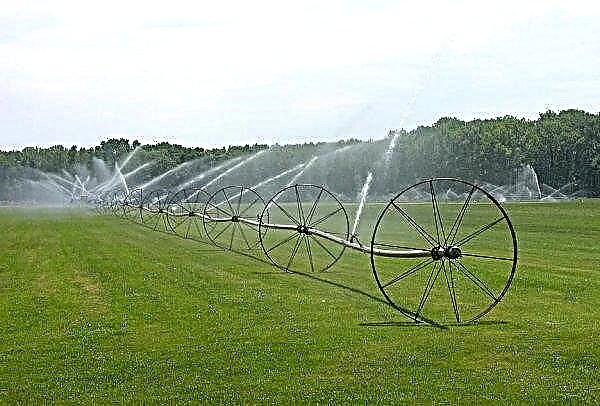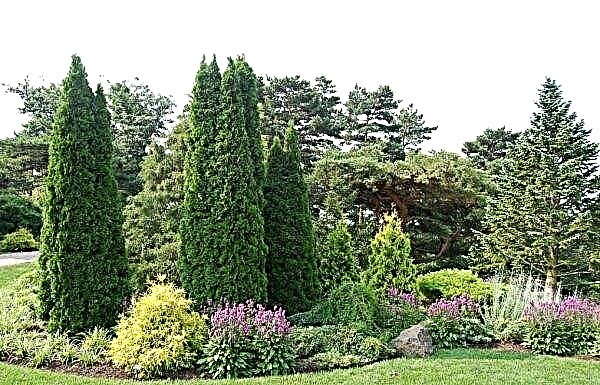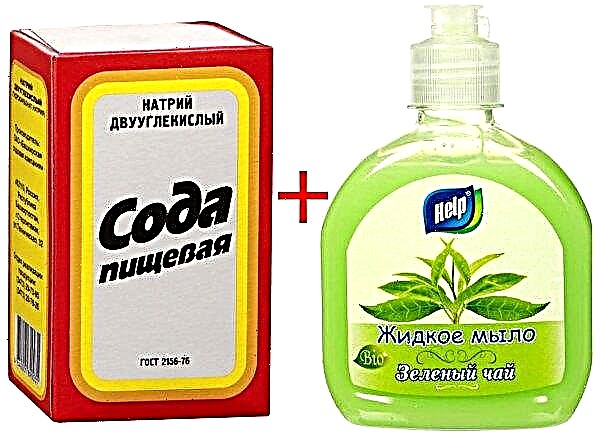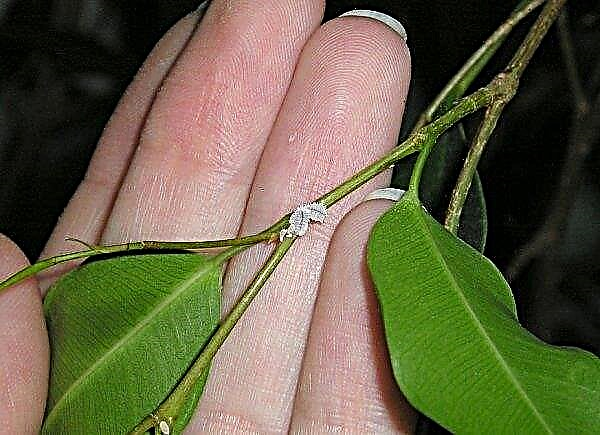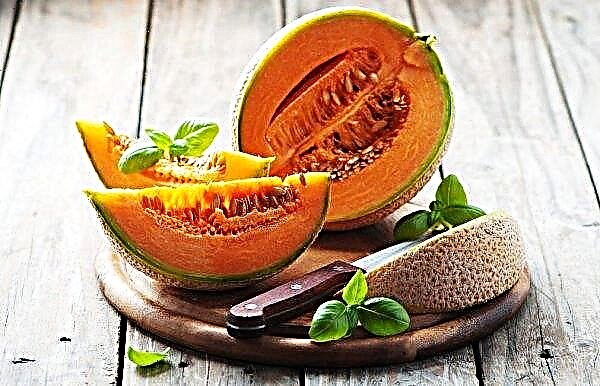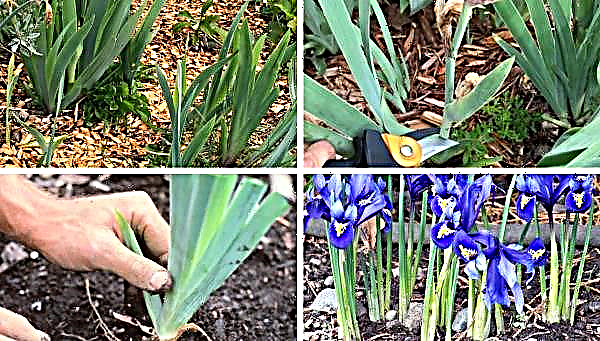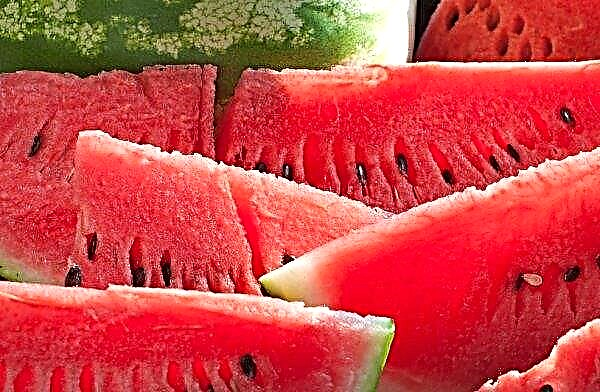With proper agricultural technology, Bugai pepper can produce fruits weighing up to 500 g. What conditions are necessary to obtain the maximum yield of this crop, read below.
Description and characteristics of the variety
Bugai pepper varieties have early ripening and long fruiting periods. Fruits reach technical maturity at 95–100 days after emergence. The fruiting phase lasts until the onset of frost.
Did you know? The Aztecs and Mayans used hot pepper instead of salt, when they did not yet know about its existence.
History of Variety Breeding
The variety was bred, thanks to the efforts of Siberian breeders V.N.Dederko and S.V. Ugarova in 2006. By 2012, culture received a patent as an outstanding achievement of Russian selection.
Productivity
Productivity is average. From 1 m² you can collect 5.5 kg of pepper.
Description of the bushes
The bushes are medium spread, compact in size. They grow to a maximum of 60 cm, which allows you to place 2 bushes per 1 m². Powerful side shoots are painted in dark green color. The bushiness of the bush is average. The leaves are oblong, pointed at the ends. They are attached to the stems by means of small cuttings, about 2-3 cm. Flowers are cup-shaped.
Consist of 5-6 petals framing the yellow core. It belongs to self-pollinated varieties, but in order to get a good beautiful crop, you need to transfer pollen from flower to flower yourself (in a greenhouse) or to plant it on a plot of bumblebees or bees. Although in vivo pollination can occur using any insects. If pollination occurs without the participation of insects, irregularly shaped fruits are formed that have an unattractive appearance.
Description of the fetus
Fruits are characterized by good keeping quality. Easy to tolerate long-term transportation, have an attractive presentation. The weight of one specimen on average varies between 150–300 g. If all the rules of agricultural technology are observed, the weight of one pepper can reach 500 g. The shape of the fruit is cuboid. Faces are clearly visible. The surface is smooth, shiny, painted green when it reaches technical maturity, bright yellow when it reaches biological maturity. The skin is thin, strong, not subject to cracking. The wall thickness varies between 0.5–1 cm. On the cut, the flesh of the honey hue is covered with small dots. Inside the fruit is divided into several departments that store a small amount of seeds. The pulp is dense, crispy, very juicy. It has a pleasant sweet, delicate, spicy taste.
The skin is thin, strong, not subject to cracking. The wall thickness varies between 0.5–1 cm. On the cut, the flesh of the honey hue is covered with small dots. Inside the fruit is divided into several departments that store a small amount of seeds. The pulp is dense, crispy, very juicy. It has a pleasant sweet, delicate, spicy taste.
Did you know? Replenishing the daily norm of ascorbic acid in the human body will help to consume only 40 g of bell pepper per day.
Advantages and disadvantages of the variety
- Pros:
- early maturity;
- long term fruiting;
- quality fruits;
- medium resistance to diseases and pests.
- Minuses:
- culture requires mandatory garter and the formation of a bush, otherwise large fruits will break the shoots;
- plentiful fruiting requires regular high-quality feeding.
Features and rules for the cultivation of the Bugai variety
To obtain a rich harvest, it is necessary to properly prepare the seeds for planting and choose the best place on the site for plants, observing crop rotation rules. Good predecessors and neighbors for culture are:
Good predecessors and neighbors for culture are:
- legumes;
- cabbage;
- cucumbers.
Adverse neighbors and predecessors:
- potatoes;
- Tomatoes
- eggplant.
Important! Hot peppers should not be planted next to hot peppers. When pollinated, bell pepper becomes bitter and loses its quality indicators.
When growing the Bugai variety, it is better to use the seedling technique. For seedlings, it is best to take individual pots and place the seeds one at a time. Peat glasses are perfect for this.
Seed selection and processing
Seeds for planting can be purchased at the store or collected independently. Seeds should be taken only from fully ripened healthy large-sized fruits. To check the seeds for germination and to disinfect, they must be placed for 1 hour in a warm (+ 30 ° C) solution of potassium permanganate. Floated seeds are rejected, and those that have settled to the bottom are transferred to the growth accelerator solution. In this regard, the drug "Zircon" is suitable. 1 ml of substance is added to 1 liter of water. In such a liquid, the seeds can withstand 10 hours. Instead of soaking in a solution, you can moisten a piece of gauze and wrap seeds in it.
Floated seeds are rejected, and those that have settled to the bottom are transferred to the growth accelerator solution. In this regard, the drug "Zircon" is suitable. 1 ml of substance is added to 1 liter of water. In such a liquid, the seeds can withstand 10 hours. Instead of soaking in a solution, you can moisten a piece of gauze and wrap seeds in it.
Preparing land for seedlings
Soil for seedlings can be purchased at the store or mixed independently in equal quantities:
- peat;
- sod-podzolic soil;
- sand.
Regardless, the soil was bought in a store or mixed independently, it must be disinfected.
There are two ways to do this:
- Calcine in the oven at a temperature of + 100 ° C.
- Pour the soil with a hot ash solution. Add 500 g of ash to 10 liters of water and boil for 10 minutes. Pour boiling water into the substrate, mix and wait until cooling to + 20 ° С.

Seeding Rules
The soil for sowing seeds should be moist. Humidity level is approximately 50-60%. The seeds are buried by 1 cm. After that, they are covered with sifted coarse-grained sand and covered with plastic containers and put into a darkened room.
Did you know? The Colorado potato beetle can live 1-3 years. To save himself from frost, he digs into the ground to a depth of 70 cm, which complicates the fight with him.
Seedling Care
Before the emergence of seedlings, seedlings care consists in daily fifteen-minute airing and moistening the soil as necessary. The air temperature in the room during this period should be +25 ... + 27 ° С. With the advent of seedlings, the film needs to be removed and the plants moved to a well-lit window sill. From this moment, the air temperature is gradually reduced to + 23 ° C. Humidity in the room is maintained within 60%, soil - 50%. Daylight hours for seedlings should be 12-14 hours. Watering is carried out once a week from the spray gun. Each plant takes about 200 ml. Each week, the water limit is increased by 50-100 ml, so that by the time of transplantation, plants already receive 1 liter of water. With the advent of the first true leaf, you can begin to apply top dressing once a month. The first dressing can be carried out with a solution of the growth accelerator, which was used to soak the seeds. The second time you need to make urea. 20 g of substance are added to 10 l of water and 200 ml of solution is added for each plant.
Watering is carried out once a week from the spray gun. Each plant takes about 200 ml. Each week, the water limit is increased by 50-100 ml, so that by the time of transplantation, plants already receive 1 liter of water. With the advent of the first true leaf, you can begin to apply top dressing once a month. The first dressing can be carried out with a solution of the growth accelerator, which was used to soak the seeds. The second time you need to make urea. 20 g of substance are added to 10 l of water and 200 ml of solution is added for each plant.
Planting seedlings in the soil
Soil preparation is carried out in several stages, including deep soil aeration (20 cm), and is as follows:
- cleaning the site of weeds and plant debris;
- aeration
- watering with 3% solution of copper sulfate;
- after a week, applying 10 kg of manure per m², on heavy soils + to this 10 kg of peat and sand;
- aeration
- spring aeration;
- the introduction of "Fitosporin" according to the instructions;
- after a week, 10 kg of compost;
- aeration.
Seedlings are planted in the soil not earlier than when it warms up to + 15 ° С. It is advisable to move plants to open ground in June. In the southern regions, you can shift the time and plant seedlings in mid-May. By the time of transplanting, the seedlings should be 2 months old, and the height of the bush should be 15 cm. 2 weeks before planting, the temperature in the room begins to gradually decrease to the same street temperature.
Important! Wood ash cannot be used in parallel with manure. It is a deoxidizing agent and neutralizes the action of nitrogen, so manure will become ineffective.
This process is called hardening and is carried out so that plants can quickly adapt to environmental conditions. As soon as the temperature regime is set, the plants begin to expose during the day on the street, and in the evening they bring it back into the room. Gradually, the time interval for staying on the street is increased, bringing it up to 24 hours. On the last day before planting, seedlings directly in pots are transferred to a permanent place. Planting scheme 50 × 50 cm. To each well add 1 tbsp. l wood ash or 30 g of superphosphate. After planting, the soil in the near-stem circle is slightly compacted and watered. For each plant contribute 1 liter of water. A day later, loosening the soil. Then spud plants. The height of the embankment is approximately 8 cm. After this, the soil is mulched with compost or fresh green grass. The height of the mulched layer is 8 cm.
Planting scheme 50 × 50 cm. To each well add 1 tbsp. l wood ash or 30 g of superphosphate. After planting, the soil in the near-stem circle is slightly compacted and watered. For each plant contribute 1 liter of water. A day later, loosening the soil. Then spud plants. The height of the embankment is approximately 8 cm. After this, the soil is mulched with compost or fresh green grass. The height of the mulched layer is 8 cm.
Rules for care after planting in the soil
In order for the bushes, and then the fruits to develop well, they need good lighting. But, in extreme heat at noon, plants need to be shaded. Otherwise, all agricultural activities are carried out as standard.
Watering and feeding
The frequency of watering depends on weather conditions, as well as the quality of the mulch. Pepper needs moderate humidity. Plants respond equally poorly to deficiency and to excess moisture. On average, 2-3 liters of water are left on the bush, at an average daily temperature of +20 ... + 25 ° С and the presence of mulch. When the temperature rises above these indicators, watering is carried out 2 times a day.
In this case, the amount of water is reduced to 1-1.5 liters per plant. The culture responds well to the sprinkling procedure, therefore it is better to water the plant under the root in the morning and to shower in the evening. Top dressing combined with watering and spend them 1-2 times a month. Approximately feeding scheme is as follows:
Approximately feeding scheme is as follows:
- 2 weeks after planting, root dressing is carried out with a solution of bird or cow droppings (diluted 1: 1 with water), 300 ml for each plant;
- in the period of budding, foliar dressing is carried out with a solution of the preparation "Emochka Fertility" (for 10 liters of water, 100 ml of the drug), 1 liter per bush;
- after flowering, root dressing with compost with ash (for 10 liters of water 3 tbsp. compost + 1 tbsp. ash) 1 liter per bush;
- during the period of fruit pouring and active fruiting, watering and spraying on the sheet with a solution of ash with nettle is carried out every 2 weeks.
Important! When using the drug "Emochka Fertility", mineral and chemical top dressing cannot be used. Also, the drug should not be used for autumn-spring tillage in frost.
Hilling and loosening the soil
Hilling is carried out after planting and a second time in a month. The procedure is necessary to stimulate the growth of additional roots so that the plant can withstand the load of the fruit. It must be carried out one day after watering. After each irrigation, the soil is loosened to a depth of 10 cm in row spacing. In parallel with loosening, weeds are being harvested and bushes are being examined for damage by diseases or pests. If hilling is carried out, then the soil is mulched only in the aisles.
Basic rules for forming a bush
Even with small growth, bushes of Bugai pepper require mandatory formation, otherwise the plant will not cope with the load. First, pinch the crown bud. This move allows the plant to develop lateral shoots. Of the lateral leaves 2-3 of the strongest shoots, the rest shorten to 1 fruitful kidney.
When shortening the shoots for each fruit, they must leave 1 top sheet. All lower shoots and leaves are completely removed. This is necessary to protect against pests and diseases, and also helps to increase productivity by redirecting juices to fruitful shoots.
Pest and Disease Control
The culture is considered resistant to diseases of fungal origin.
But, if the rules of agricultural technology are not respected, then it may be amazed:
- Tobacco Mosaic - a viral disease that manifests itself in non-compliance with crop rotation rules. There is no effective treatment for it. The only thing that can be done is to cut off all the affected parts of the plant, but this does not guarantee that the virus did not remain in the plant cells.
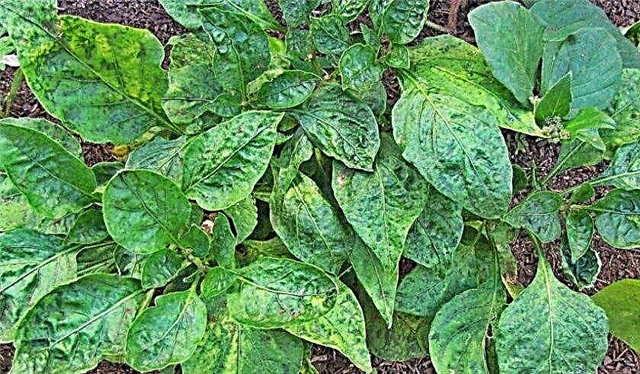
- Fusarium - fungal disease, manifested with increasing humidity. The affected parts of the plant must be removed, the top 5 cm of soil removed and replaced with coarse sand mixed 1: 1 with peat and wood ash. The bushes are dusted with a mixture of ash and foundationazole.
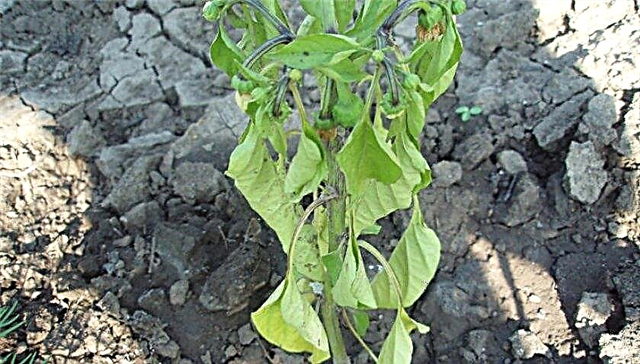
- Cladosporiosis - Another fungal disease. The technique of treatment, as in Fusarium.

Among pests for pepper of this variety, the Colorado potato beetle is dangerous.
The following drugs will be effective against it:
- "Aktara";
- Confidor
- "Bitoxibacillin."
Important! The Colorado potato beetle very quickly develops immunity to chemical and biological drugs, so treatment must be carried out several times a season using various means.
Harvesting and Harvesting
Harvest must be harvested in the phase of technical ripeness. This will make it possible to extend the fruiting period and relieve the load from the bush. Peppers are harvested with the stalk with a sharp knife. The cut should be done at a distance of 3-5 cm from the attachment to the stem. The culture by its purpose belongs to the salad type, but this does not prevent it from being used not only in fresh form, but also for cooking second courses, side dishes, and also canning. Peppers of this variety are excellent for preparing multi-component dishes that can be consumed immediately or canned. In addition, fresh peppercorns can be cut into compact cubes or cubes and frozen. Bugai pepper is a leader among farmers due to its quality characteristics. With optimal care, plants are able to form record-breaking fruits.
Peppers of this variety are excellent for preparing multi-component dishes that can be consumed immediately or canned. In addition, fresh peppercorns can be cut into compact cubes or cubes and frozen. Bugai pepper is a leader among farmers due to its quality characteristics. With optimal care, plants are able to form record-breaking fruits.




